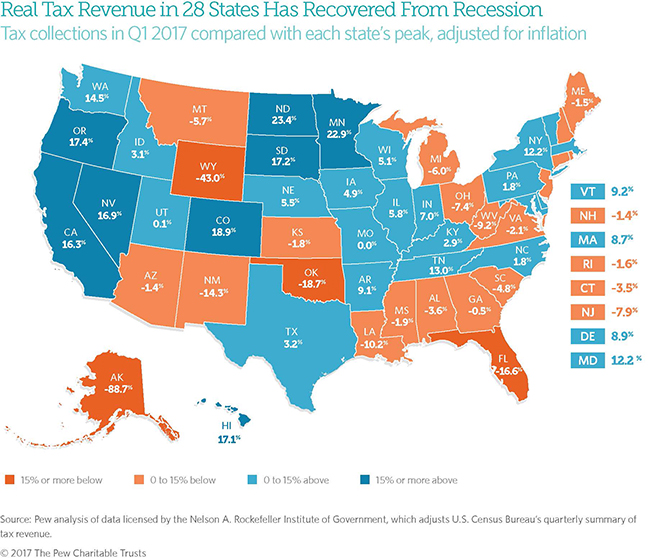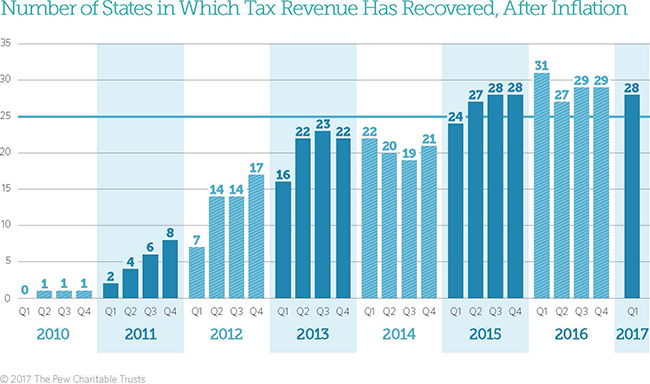Connecting state and local government leaders
Individual state results have differed dramatically depending on economic conditions, population changes and tax policy choices since the recession.
This article was originally published by States' Fiscal Health, an initiative of The Pew Charitable Trusts, and was written by Barb Rosewicz and Daniel Newman.
Nearly eight years into the nation’s economic recovery, state tax revenue in total and in 28 states was higher in the first quarter of 2017 than before it plunged during the Great Recession, after adjusting for inflation. But growth in tax collections tapered off over the past year, contributing to budget pressures in a number of states.
Total state tax collections nudged up in early 2017 but not by enough to offset a recent slowdown in 50-state tax revenue growth.
States collectively took in 5.7 percent more in the first quarter of 2017 than when total receipts peaked in the third quarter of 2008 before falling during the downturn, after accounting for inflation and averaging across four quarters to smooth seasonal fluctuations. The latest quarter was an improvement after a rare decline in mid-2016 and two quarters of stalled growth. But it still was short of a year earlier, when tax revenue hit a post-recession high of 6.6 percent above its peak during the recession.
The results mean that the 50 states combined had the equivalent of 5.7 cents more in purchasing power at the start of 2017 for every $1 they collected at their peak in 2008.
But with little short-term growth in purchasing power, more states than at any time since the end of the recession reported midyear budget gaps in fiscal year 2017, which has now ended. And an unusually large number—11 states—were late passing balanced budgets by the July 1 start of most states’ current fiscal year, amid forecasts that tax revenue growth will remain sluggish in fiscal 2018.
Slow growth can make it hard for states to balance their budgets. Even if revenue increases, states may face higher expenditures due to population growth, changes in Medicaid costs and enrollment, and deferred or new needs for schools, safety-net programs, corrections, employee salaries and pensions, and road maintenance and construction.
Since the 2007-09 recession, total state tax revenue has been slower to rebound than after any of the three previous downturns. But trends have varied widely by state. In eight of the 28 states in which collections had recovered from their losses in the recession by early 2017, tax revenue—and thus purchasing power—was more than 15 percent higher than at its peak before or during the recession. Conversely, collections were down 15 percent or more in four of the 22 states in which tax revenue was still below peak.

State Highlights
A comparison of each state’s tax receipts in the first quarter of 2017 with its peak quarter of revenue before the end of the recession, averaged across four quarters and adjusted for inflation, shows:
- Eight states posted tax revenue rebounds of 15 percent or more: North Dakota (23.4 percent), Minnesota (22.9 percent), Colorado (18.9 percent), Oregon (17.4 percent), South Dakota (17.2 percent), Hawaii (17.1 percent), Nevada (16.9 percent), and California (16.3 percent).
- North Dakota remained the leader among all states in tax revenue growth since the recession, although its collections have dropped dramatically since the 2014 plunge in oil prices. At the end of that year, receipts hit a high of 124.5 percent above their peak during the recession, compared with 23.4 percent above in the first quarter of 2017. Besides the decline in oil-related tax dollars, an income tax cut enacted in 2015 also reduced revenue.
- Alaska (-88.7 percent) was furthest below its peak. This means the state collected only about 11 percent as much in inflation-adjusted tax dollars as it did at its short-lived peak in 2008, when a new state oil tax coincided with record-high crude prices. Without personal income or general sales taxes, Alaska is highly dependent on oil-related severance tax revenue, which began falling even before worldwide crude prices declined in 2014 as its oil production waned.
- Three additional states were down more than 15 percent from their previous peaks: Florida (-16.6 percent), Oklahoma (-18.7 percent), and Wyoming (-43.0 percent).
- Wyoming (-43.0 percent) hit a new low in tax collections since the recession amid weakness in coal, oil, and natural gas industries.
- Five states had at least a full year of declining tax revenue: Illinois, Kansas, Nebraska, Oklahoma, and Wyoming. The lengthiest slide—of 10 straight quarters—has been in Illinois, where a temporary personal income tax increase expired at the end of 2014 but a permanent one will take effect in mid-2017.
Latest Trends
Although total tax revenue rose in the first quarter of 2017, inflation-adjusted receipts fell in 18 states, including in eight of the 28 in which receipts had recovered from their recession-era losses.
Preliminary figures show that total state tax revenue grew but at a slower pace in the second quarter of 2017 as the budget year ended in all but four states, in part because of a projected drop in personal income tax collections, according to the Nelson A. Rockefeller Institute of Government. States collectively forecast that sluggish tax revenue growth will continue in fiscal 2018.
State tax revenue—like the U.S. economy—has grown slowly and unevenly since the recession. In the past couple of years, low commodity prices have further restrained tax revenue growth in a number of energy and farming states. More broadly, state revenue has languished amid weak growth in wages and consumer spending, which also has been migrating toward services and online purchases that are less likely to be taxed.
On the plus side, investment gains from a strong stock market hold potential for growth in state income taxes, according to Moody’s Investors Service. However, states might not see extra revenue in the short term because some taxpayers—especially high-income earners—could delay earnings or other income in case their tax liabilities might be lower under federal tax changes proposed by President Donald Trump.
State policymakers also have contributed to revenue trends, enacting tax cuts in states such as North Dakota and Texas and hikes in states such as Louisiana and Washington. According to data from the National Association of State Budget Officers, states in fiscal 2016 and 2017 enacted more tax hikes than cuts overall, after doing the reverse in the two previous years.
Trends Since the Recession
Nationally, tax revenue recovered from its losses in mid-2013, after accounting for inflation. But individual state results have differed dramatically depending on economic conditions, population changes, and tax policy choices since the recession.

In 2010, North Dakota was the first state to surpass its recession-era peak, followed by Vermont, then Arkansas and New York by mid-2011. Tax receipts were above peak in eight states at the end of calendar 2011; 17 states at the end of 2012; 22 states at the end of 2013; 21 states at the end of 2014; 28 states at the end of 2015; and 29 states at the end of 2016.
The number of states that have regained their tax revenue levels has risen and fallen, reflecting increased volatility in state tax collections as well as tax policy changes.
Among states in which tax revenue has recovered, some, such as Nevada and Washington, have raised taxes since the recession, contributing to gains. Among states in which receipts remain below their previous peaks, some, such as Florida and Ohio, chose to cut taxes since the recession.
State budgets do not adjust revenue for inflation, so tax revenue totals in states’ own documents will appear higher than or closer to pre-recession totals. Without adjusting for inflation, 50-state tax revenue was 20 percent above peak and tax collections had recovered in 46 states—all except Alaska, Florida, Oklahoma, and Wyoming—as of the first quarter of 2017. Unadjusted figures do not take into account changes in the price of goods and services.
Adjusting for inflation is just one way to evaluate state tax revenue growth. Different insights would be gained by tracking revenue relative to population growth or state economic output.
Download the data to see individual state trends from the first quarter of 2006 to the first quarter of 2017. Visit The Pew Charitable Trusts’ interactive resource Fiscal 50: State Trends and Analysis to sort and analyze data for other indicators of state fiscal health.

NEXT STORY: Mayors Not Letting Up in Fight to Preserve the State and Local Tax Deduction



